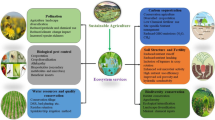Abstract
Today, protecting the environment, considering the idea of sustainability, using natural resources, and considering long-term interests are among the most crucial factors in organizing and overseeing agriculture in any nation’s economy. Afghanistan is a dry and landlocked country where agriculture contributes significantly to employment and the people’s economy to attain both profitability and environmental sustainability, the use of mathematical programming models plays a significant role. In this research, the fuzzy goal programming method is considered to optimize the cropping pattern in three scenarios including profit maximization (fuzzy 1), sustainable development of agriculture and optimal use of water resources (fuzzy 2), and simultaneous achievement of the goals mentioned above (fuzzy 3). The data required for this research was obtained through a field survey of the completion of 928 questionnaires.
The results obtained from the fuzzy goal model (3) that simultaneously considers economic and environmental goals are significant. The removal of five products (paddy, melon, watermelon, onion, and cabbage) from the cropping pattern results in a decrease of 29.01% of the total cultivated area compared to the current model in Nangarhar province. The implementation of this model shows a 0.67% increase in gross margin, equivalent to $6.90 million. The reduction in the consumption of agricultural inputs, including chemical fertilizers, agricultural pesticides, and irrigation water, by 16.92%, 30.69%, and 39.97%, respectively, aligns with sustainable agricultural practices aimed at minimizing environmental impact and promoting resource efficiency. By decreasing the use of chemical fertilizers, pesticides, and irrigation water, farmers can contribute to reducing potential environmental pollution and conserving water resources.

Similar content being viewed by others
Data Availability
The datasets generated during the current study are available from the corresponding author upon reasonable request.
References
Basumatary UR, Mitra DK (2020) A study on optimal land allocation through fuzzy multi-objective linear programming for agriculture production planning in Kokrajhar district, BTAD, Assam, India. Int J Appl Eng Res 15(1):94–100. https://www.ripublication.com/ijaer20/ijaerv15n1_14.pdf
Biswas A, Pal BB (2005) Application of fuzzy goal programming technique to land use planning in agricultural system. Omega 33(5):391–398. https://doi.org/10.1016/j.omega.2004.07.003
Biswas P, Pal BB (2015) Fuzzy goal programming approach to solve linear multilevel programming problems using genetic algorithm. Int J Comput Appl 115(3):10–19. https://doi.org/10.5120/20130-2215
Dahmardeh Ghaleno MR, Sheikh V, Sadoddin A, Sabouhi Sabouni M (2016) Optimal cropping pattern for water resources management in Sistan region of Iran using goal programming method. Ecopersia 4(4):1555–1567. https://doi.org/10.18869/modares.Ecopersia.4.4.1555
Fathi F, Zibaei M (2020) Optimal crop pattern management in firozabad plain according to water and soil sustainability by applying fuzzy mathematical programming. J Agric Sci Sustain Prod 30(3):331–345. (In Persian). https://www.researchgate.net/publication/347836341
Hakmanage NM, Chandrasekara NV, Jayasundara M (2022) Application of fuzzy goal programming model to assess optimal multi crop cultivation planning. Agric Nat Resour 56(1):193–202. https://doi.org/10.34044/j.anres.2021.56.1.18
Joolaie R, Abedi Sarvestani A, Taheri F, Van Passel S, Azadi H (2017) Sustainable cropping pattern in North Iran: application of fuzzy goal programming. Environ Dev Sustain 19:2199–2216. https://doi.org/10.1007/s10668-016-9849-9
Kumari M, Singh OP, Meena DC (2017) Optimising cropping pattern in eastern Uttar Pradesh using Sen’s multi objective programming approach. Agric Econ Res Rev 30(347-2018–2897):285–295. https://doi.org/10.5958/0974-0279.2017.00049.0
Malik ZA, Kumar R, Pathak G, Roy H, Malik MAUD (2023) Application of fuzzy goal programming approach in the real-life problem of agriculture sector. Braz J Oper Prod Manag 20(1):1516–1516. https://doi.org/10.14488/BJOPM.1516.2023
Mardani Najafabadi M, Ziaee S, Nikouei A, Borazjani MA (2019) Mathematical programming model (MMP) for optimization of regional cropping patterns decisions: a case study. Agric Syst 173:218–232. https://doi.org/10.1016/j.agsy.2019.02.006
Mirkarimi S, Joolaie R, Eshraghi F, Shirani Bid Abadi F (2016) Cropping pattern management of crops with emphasis on environmental considerations (case study: amol tonship). J Environ Sci Technol 18(3):253–263. (In Persian). https://sanad.iau.ir/Journal/jest/Article/839860/FullText
Moulogianni C (2022) Comparison of selected mathematical programming models used for sustainable land and farm management. Land 11(8):1293. https://doi.org/10.3390/land11081293
Muradi AJ, Boz I (2018) The contribution of agriculture sector in the economy of Afghanistan. Int J Sci Res Manag 6(10):750–755. https://doi.org/10.18535/ijsrm/v6i10.em04
Neamatollahi E, Vafabakhshi J, Jahansuz MR, Sharifzadeh F (2017) Agricultural optimal cropping pattern determination based on fuzzy system. Fuzzy Inform Eng 9(4):479–491. https://doi.org/10.1016/j.fiae.2017.12.004
Polasi S, Shalini K (2024) Optimizing agricultural sustainability: a comparative analysis of crop plans through goal programming and R programming. https://doi.org/10.21203/rs.3.rs-3998557/v1
Rasikh ZUR, Amini A, Niazi S, Joolaie R, Mirkarimi S (2023) Analysis ofthe consequences of agricultural policies on the cropping pattern of agricultural products and employment in Afghanistan. Aust J Eng Innov Technol 5(5):206–215. https://doi.org/10.34104/ajeit.023.02060215
Ren C, Guo P, Tan Q, Zhang L (2017) A multi-objective fuzzy programming model for optimal use of irrigation water and land resources under uncertainty in Gansu Province, China. J Clean Prod 164:85–94. https://doi.org/10.1016/j.jclepro.2017.06.185
Sharma DK (2007) Fuzzy goal programming for agricultural land allocation problems. Yugosl J Oper Res 17(1). https://doi.org/10.2298/YUJOR0701031S
Soleymani S, Zare Mehrjerdi MR, Amirtaimoori S, Mehrabi Boshrabadi H (2021) Environmental approach to determining optimal cropping pattern. Environ Resour Res 9(1):79–88. https://doi.org/10.22069/ijerr.2021.5530
Soltani HA, Khajehpour E (2020) Optimal cropping pattern in Afghanistan considering environmental sustainability. Int J Agric Manag Dev (IJAMAD) 10(4):333–346. https://doi.org/10.22004/ag.econ.335136
Vinsensia D, Utami Y, Simanjuntak MS, Tarigan AR (2021) Study of fuzzy goal programming model to production planning problems approach. Jurnal Teknik Informatika CIT Medicom 13(2):75–81. https://doi.org/10.35335/cit.Vol13.2021.149.pp75-81
Wang J, Sun T, Wang X (2022) Research on the application of water resources optimal allocation model based on fuzzy optimization theory. Pol J Environ Stud 31(6). https://doi.org/10.15244/pjoes/150046
Author information
Authors and Affiliations
Corresponding author
Ethics declarations
Conflict of Interest
The authors declare no competing interests.
Additional information
Publisher's Note
Springer Nature remains neutral with regard to jurisdictional claims in published maps and institutional affiliations.
Rights and permissions
Springer Nature or its licensor (e.g. a society or other partner) holds exclusive rights to this article under a publishing agreement with the author(s) or other rightsholder(s); author self-archiving of the accepted manuscript version of this article is solely governed by the terms of such publishing agreement and applicable law.
About this article
Cite this article
Rasikh, Z.U.R., Joolaie, R., Keramatzadeh, A. et al. Optimizing the Cropping Pattern in Nangarhar Province Based on the Perspective of Sustainable Agricultural Development: Fuzzy Goal Programming Approach. Process Integr Optim Sustain (2024). https://doi.org/10.1007/s41660-024-00417-3
Received:
Revised:
Accepted:
Published:
DOI: https://doi.org/10.1007/s41660-024-00417-3




